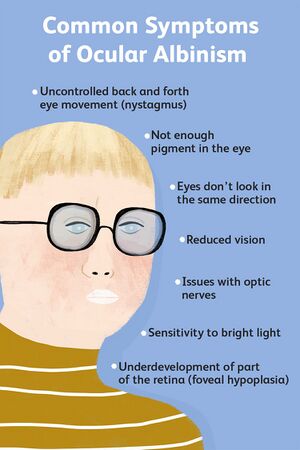Albinism: Difference between revisions
A Aishwarya (talk | contribs) No edit summary |
A Aishwarya (talk | contribs) No edit summary |
||
| Line 1: | Line 1: | ||
MMutaThis article or area is currently under construction and may only be partially complete. Please come back soon to see the finished work! ({{REVISIONDAY}}/{{REVISIONMONTH}}/{{REVISIONYEAR}}) | |||
== Introduction == | == Introduction == | ||
| Line 13: | Line 13: | ||
== Sub-Types of Albinism == | == Sub-Types of Albinism == | ||
{| class="wikitable | {| class="wikitable" | ||
|+ | |+ | ||
!'''OCA1''' | !'''OCA1''' | ||
| Line 22: | Line 22: | ||
|Mutations in TYR Gene | |Mutations in TYR Gene | ||
Chromosome 11 | |||
Tyrosine | Tyrosine deficiency | ||
|Mutations in OCA2 Gene | |Mutations in OCA2 Gene | ||
| Line 36: | Line 32: | ||
Most common type of OCA in the world. | Most common type of OCA in the world. | ||
|Mutations in TYRP1 Gene | |||
Chromosome 9 | |||
Stabilizes Tryosinase | |||
|Mutations in SLC45A2 Gene | |||
Chromosome 5 | |||
Membrane Transport protein | |||
|- | |||
|''OCA1a:'' Complete absence of melanin | |''OCA1a:'' Complete absence of melanin | ||
''OCA1b:'' Some melanin present | ''OCA1b:'' Some melanin present | ||
| | |Brown OCA | ||
|Red OCA | |||
|Nearly normal melanin | |||
| | |||
| | |||
|- | |- | ||
| | |Most common globally | ||
| | |Common in people of African | ||
| | |Common in southern Africa | ||
| | |Common in East Asian | ||
|} | |} | ||
Revision as of 18:45, 25 November 2023
MMutaThis article or area is currently under construction and may only be partially complete. Please come back soon to see the finished work! (25/11/2023)
Introduction[edit | edit source]
Albinism, a latin word albus that means "white" is a genetic condition characterized by a lack of melanin. Melanin is a pigment that gives color to the hair, skin and eyes. It is an inherited when an individual receives two copies of a recessive gene that causes a lack of melanin production. There are different types of albinism.
- Oculocutaneous Albinism (OCA): This affects the person's skin, hair, and eyes. Due to little or no melanin in these areas, the skin and hair color is very light with blue or violet eyes. OCA is further subdivided into (based on mutations invovled):
- OCA1
- OCA2
- OCA3
- OCA4
- Ocular Albinism (OA): This primarily affects the eye. These individuals may have little or no pigmentation in the iris and retina that leads to vision problem. In OA the skin and hair colour might appear normal. This is associated with issues such as Nystagmus and strabismus.[1]
Relavent anatomy[edit | edit source]
Sub-Types of Albinism[edit | edit source]
| OCA1 | OCA2 | OCA3 | OCA4 |
|---|---|---|---|
| Mutations in TYR Gene
Chromosome 11 Tyrosine deficiency |
Mutations in OCA2 Gene
Chromosme 15 Melanosomal membrane protein Most common type of OCA in the world. |
Mutations in TYRP1 Gene
Chromosome 9 Stabilizes Tryosinase |
Mutations in SLC45A2 Gene
Chromosome 5 Membrane Transport protein |
| OCA1a: Complete absence of melanin
OCA1b: Some melanin present |
Brown OCA | Red OCA | Nearly normal melanin |
| Most common globally | Common in people of African | Common in southern Africa | Common in East Asian |
Causes of albinism[edit | edit source]
Clinical Presentation[edit | edit source]
Management/Interventions[edit | edit source]
Current Literature[edit | edit source]
Refrences[edit | edit source]
- ↑ Marçon CR, Maia M. Albinism: epidemiology, genetics, cutaneous characterization, psychosocial factors. Anais brasileiros de dermatologia. 2019 Dec 9;94:503-20.










